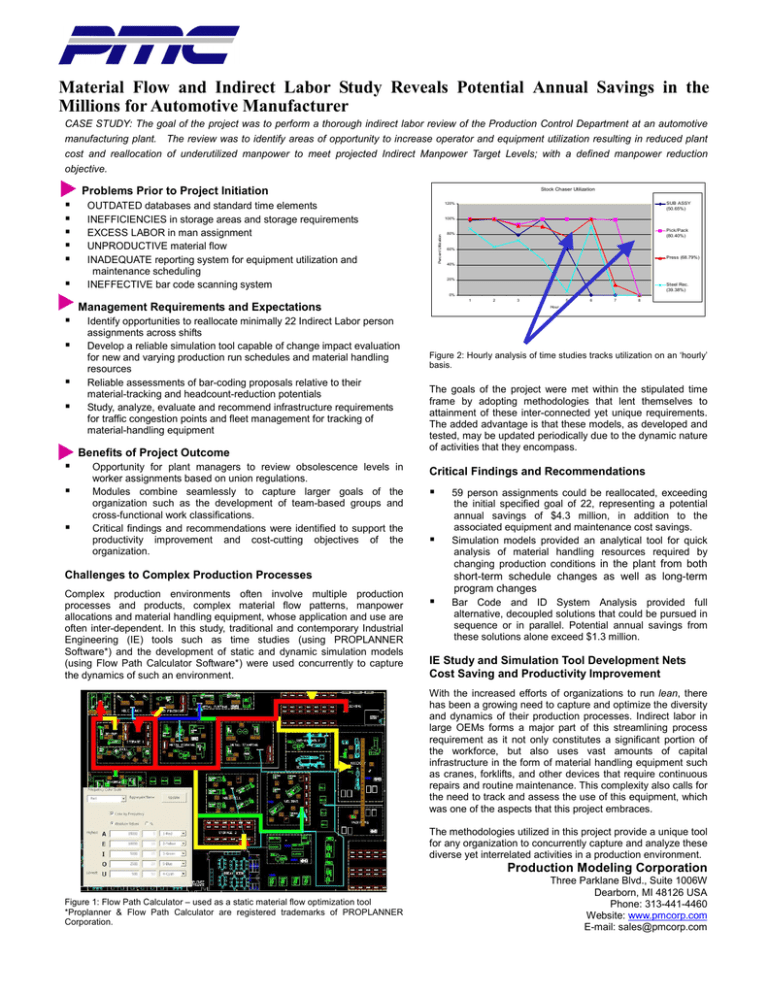Material Flow and Indirect Labor ... Millions for Automotive Manufacturer
advertisement

Material Flow and Indirect Labor Study Reveals Potential Annual Savings in the Millions for Automotive Manufacturer CASE STUDY: The goal of the project was to perform a thorough indirect labor review of the Production Control Department at an automotive manufacturing plant. The review was to identify areas of opportunity to increase operator and equipment utilization resulting in reduced plant cost and reallocation of underutilized manpower to meet projected Indirect Manpower Target Levels; with a defined manpower reduction objective. Problems Prior to Project Initiation Stock Chaser Utilization OUTDATED databases and standard time elements INEFFICIENCIES in storage areas and storage requirements EXCESS LABOR in man assignment UNPRODUCTIVE material flow INADEQUATE reporting system for equipment utilization and maintenance scheduling INEFFECTIVE bar code scanning system SUB ASSY (50.65%) 120% 100% Percent Utilization Pick/Pack (80.40%) 80% 60% Press (68.79%) 40% 20% Steel Rec. (39.38%) 0% 1 Management Requirements and Expectations Identify opportunities to reallocate minimally 22 Indirect Labor person assignments across shifts Develop a reliable simulation tool capable of change impact evaluation for new and varying production run schedules and material handling resources Reliable assessments of bar-coding proposals relative to their material-tracking and headcount-reduction potentials Study, analyze, evaluate and recommend infrastructure requirements for traffic congestion points and fleet management for tracking of material-handling equipment Benefits of Project Outcome Opportunity for plant managers to review obsolescence levels in worker assignments based on union regulations. Modules combine seamlessly to capture larger goals of the organization such as the development of team-based groups and cross-functional work classifications. Critical findings and recommendations were identified to support the productivity improvement and cost-cutting objectives of the organization. 3 4 5 6 7 8 Hour Figure 2: Hourly analysis of time studies tracks utilization on an ‘hourly’ basis. The goals of the project were met within the stipulated time frame by adopting methodologies that lent themselves to attainment of these inter-connected yet unique requirements. The added advantage is that these models, as developed and tested, may be updated periodically due to the dynamic nature of activities that they encompass. Critical Findings and Recommendations Challenges to Complex Production Processes Complex production environments often involve multiple production processes and products, complex material flow patterns, manpower allocations and material handling equipment, whose application and use are often inter-dependent. In this study, traditional and contemporary Industrial Engineering (IE) tools such as time studies (using PROPLANNER Software*) and the development of static and dynamic simulation models (using Flow Path Calculator Software*) were used concurrently to capture the dynamics of such an environment. 2 59 person assignments could be reallocated, exceeding the initial specified goal of 22, representing a potential annual savings of $4.3 million, in addition to the associated equipment and maintenance cost savings. Simulation models provided an analytical tool for quick analysis of material handling resources required by changing production conditions in the plant from both short-term schedule changes as well as long-term program changes Bar Code and ID System Analysis provided full alternative, decoupled solutions that could be pursued in sequence or in parallel. Potential annual savings from these solutions alone exceed $1.3 million. IE Study and Simulation Tool Development Nets Cost Saving and Productivity Improvement With the increased efforts of organizations to run lean, there has been a growing need to capture and optimize the diversity and dynamics of their production processes. Indirect labor in large OEMs forms a major part of this streamlining process requirement as it not only constitutes a significant portion of the workforce, but also uses vast amounts of capital infrastructure in the form of material handling equipment such as cranes, forklifts, and other devices that require continuous repairs and routine maintenance. This complexity also calls for the need to track and assess the use of this equipment, which was one of the aspects that this project embraces. The methodologies utilized in this project provide a unique tool for any organization to concurrently capture and analyze these diverse yet interrelated activities in a production environment. Production Modeling Corporation Figure 1: Flow Path Calculator – used as a static material flow optimization tool *Proplanner & Flow Path Calculator are registered trademarks of PROPLANNER Corporation. Three Parklane Blvd., Suite 1006W Dearborn, MI 48126 USA Phone: 313-441-4460 Website: www.pmcorp.com E-mail: sales@pmcorp.com






